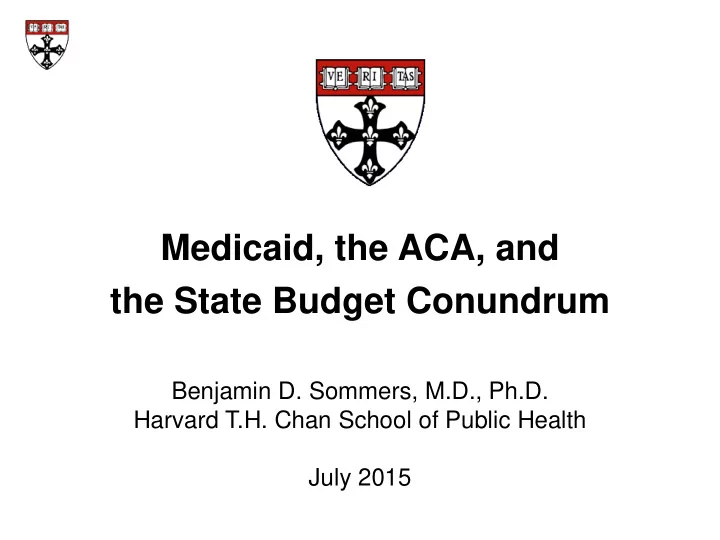

Medicaid, the ACA, and the State Budget Conundrum Benjamin D. Sommers, M.D., Ph.D. Harvard T.H. Chan School of Public Health July 2015
Status Update • So far, 29 states (plus Washington DC) have chosen to expand Medicaid • Of remaining 21 states, the camps divide into: Still negotiating: Willing to expand under certain – conditions, usually more state control and conservative features – Still debating: in legislative discussions. – Never. Ever. 2
Medicaid Choices What the governors are saying… Source: Sommers & Epstein, 2013 3
Medicaid Choices What the governors are saying… Source: Sommers & Epstein, 2013 4
State Budget Concerns “Collectively states are spending more on • Medicaid than they do on K-12 education.” The ACA expansion is “the classic gift of a baby • elephant. . . .The federal government says, ‘We’ll pay for all the hay — for the first few years.’” “At any whim [the feds] could just pull the • money. So yeah, I’m a little gun-shy.” Sources: Sommers & Epstein, 2013; PolitiFact 2013 5
ACA & State Budgets States often report the % they spend including • federal dollars, which is misleading Medicaid: 22% of state spending – – 60% paid for by feds currently – Nets out to 12% of state-generated revenue • For pre-ACA eligible, fed gov’t pays 50-83% of total Medicaid costs, depending on the state • For the ACA newly-eligible, 100% funding until 2016, then down to 90% after 2020 6
Medicaid Costs • But – Medicaid costs are the fasting growing part of the state budget • And – Medicaid spending is countercyclical: Enrollment surges when economy stalls, just when tax revenue craters 7
Medicaid Costs • But – Medicaid costs are the fasting growing part of the state budget • And – Medicaid spending is countercyclical: Enrollment surges when economy stalls, just when tax revenue craters Feds have twice increased the match rate to help states during recessions, and once (1981) cut it. Costs have grown rapidly primarily because of enrollment growth. Per person costs have grown slower in Medicaid than for other types of insurance. Source: Holahan & Yemane 2009 8
ACA & the ‘ Woodwork Effect ’ • ACA pays 90-100% of newly-eligible enrollees in Medicaid • States still pay traditional match on those eligible under old rules • Millions of these currently-eligible individuals may come out of the woodwork under the ACA 9
The ‘ Woodwork Effect: ’ Medicaid-Eligible but Uninsured > 5% 4% - 5% 3% - 4% 2% - 3% ≤ 2% Source: Sommers & Epstein, 2011 National Total = 3.8% (9.1 million people) 10
ACA & States: The Bottom Line • Federally-subsidized expansion will offset state spending on uncompensated care • Increase in effective match rate for some Medicaid enrollees – pregnant women, medically needy • Estimated net effect if all 50 expand: $130B in state savings over 5 years Sources: Dorn & Buettgens 2010; Bachrach SHADAC 2015 11
Medicaid and Cost Growth • While ACA expansion is not a leading threat to most state budgets, other budgetary concerns are quite real: – Costs for pre-ACA eligible individuals with significant medical complexity and LTC needs – Rapid increase in federal expenditures on Medicaid under the ACA 12
Total Medicaid Spending $500 Medicaid Expenditures, 2014 Dollars, $450 $400 in Billions $350 $300 $250 $200 $150 $100 $50 $0 1966 1968 1970 1972 1974 1976 1978 1980 1982 1984 1986 1988 1990 1992 1994 1996 1998 2000 2002 2004 2006 2008 2010 2012 2014 Total Expenditures (State and Federal) Source: Iglehart & Sommers NEJM 2015
Enrollment vs. Per Capita Costs 70 $9,000 Enrollment, in Millions Spending per Enrollee, in 2014 Dollars $8,000 60 $7,000 50 $6,000 40 $5,000 $4,000 30 $3,000 20 $2,000 10 $1,000 0 $0 1966 1968 1970 1972 1974 1976 1978 1980 1982 1984 1986 1988 1990 1992 1994 1996 1998 2000 2002 2004 2006 2008 2010 2012 2014 Enrollment Spending Per Enrollee Source: Iglehart & Sommers NEJM 2015
Enrollment versus Costs 15 Source: Kaiser Commission (2015) using 2011 MSIS data
Costs: Policy Options • Managed Care: Evidence that it saves money is equivocal, but states are optimistic • Cutting benefits or requiring cost-sharing • Cutting provider reimbursement Payment reform and care delivery redesign, • especially for high-cost complex patients State Block Grants: capping total spending and • shifting burden to states to save money 16
Costs: Focus on Duals • Renewed energy at state and federal level to improve quality and efficiency of care for sickest members • ACA created the “Duals Office” (Medicare-Medicaid Coordination) • Overseeing Dual Demonstration Projects Aggressive move by some states to shift duals and • disabled into MCOs 17
Physician Participation % US Office-Based Physicians Accepting New Medicaid Patients 18 Source: Decker, Health Affairs (2012)
Providers: A Contrarian View • Do we need 100% of doctors to take Medicaid? – If only 82% of doctors take new privately insured patients, is that a problem? • Do we have evidence that provider participation is a problem for beneficiaries? 19
Providers: Access to Care 20
Providers: Access to Care 21
Providers: Access to Care 22
Conclusions • Cost pressures in Medicaid are real • State opposition to ACA Medicaid expansion cites costs, but main cost burden of ACA is federal • State costs still largely driven by pre-ACA groups, especially people with disabilities and those in LTC Among common cost-control options, enthusiasm • for MMC and concerns about provider pay cuts are supported by mixed/weak evidence. Care delivery redesign may be most promising. • 23
Other Questions & Comments? Ben Sommers bsommers@hsph.harvard.edu 24
Recommend
More recommend